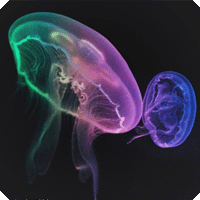|
基因组揭示栉水母祖先起源
动物进化过程是逐渐从低等海绵类到适应当今地球的触手类动物、有翼和有智力物种。生物学家通过基因组测序数据发现海绵可能是晚于称为栉水母的水生物。 width="400";
width="400";
>
尽管他们呈现类似水母的凝胶状,栉水母形成他们自己的栉水母门类。生命树典型地显示栉水母系位于包含水母和海葵以及包括有头及尾动物(包括蝇、人类等)的组间。栉水母在海水中以闪亮的纤毛游动,利用粘性触须诱捕猎物。他们比海绵更复杂,他们具有神经、肌肉、组织层以及光感器,这些都是海绵所不具备的。
因为栉水母位于动物生命树的基础位置,这个发现提示光分生和传感蛋白的进化与多细胞进化的时间相同。在现今的动物中,这样的蛋白也许提高了光传感分子多样性,例如在人的眼睛中的杆和视锥细胞。
Genome reveals comb jellies' ancient origin
Sequencing data challenge sponges' claim to primacy in animal kingdom.
Amy Maxmen; 08 January 2013; San Francisco
Animals evolved gradually, from the lowly sponge to the menagerie of tentacled, winged and brainy creatures that inhabit Earth today. This idea makes such intuitive sense that biologists are now stunned by genome-sequencing data suggesting that the sponges were preceded by complex marine predators called comb jellies.
Although they are gelatinous like jellyfish, comb jellies form their own phylum, known as ctenophores. Trees of life typically root the comb jellies' lineage between the group containing jellyfish and sea anemones and the one containing animals with heads and rears - which include slugs, flies and humans. Comb jellies paddle through the sea with iridescent cilia and snare prey with sticky tentacles. They are much more complex than sponges - they have nerves, muscles, tissue layers and light sensors, all of which the sponges lack.
“It’s just wild to imagine” that comb jellies evolved before sponges, says Billie Swalla, a developmental biologist at the University of Washington in Seattle and a leading member of the team sequencing the genome of the comb jelly Pleurobrachia bachei. But the team is suggesting just that, in results they presented at the annual meeting of the Society for Integrative and Comparative Biology, held on 3-7 January in San Francisco, California.
Despite comb jellies' complexity, DNA sequences in the Pleurobrachia genome place them at the base of the animal tree of life, announced Swalla's colleague Leonid Moroz, a neurobiologist at the University of Florida in Gainesville. Another team presented results from genome sequencing for the comb jelly Mnemiopsis leidyi, and found that the phylum lands either below, or as close to the base as, sponges on the tree.
“We’ve always thought that predator-prey interactions and sensory adaptations evolved long after the origin of sponges,” Swalla says. “Now we need to imagine early life as a sponge, ctenophore and everything in between.” Because millions of species have gone extinct since animals appeared some 542 million years ago, Swalla says, the ancestor of all animals might look different from modern comb jellies and sponges.
Gene families, cell-signalling networks and patterns of gene expression in comb jellies support ancient origins as well. For example, Moroz and his team found that comb jellies grow their nerves with unique sets of genes. “These are aliens,” Moroz jokes. He suggests that comb jellies might be descendants of Ediacaran organisms, mysterious organisms that appear in the fossil record before animals. Indeed, in 2011, palaeontologists claimed that one of these 580-million-year-old fossils resembled comb jellies.
Andy Baxevanis, a comparative biologist at the US National Human Genome Research Institute in Bethesda, Maryland, and a leader on the Mnemiopsis genome project, says that comb jellies are the only animals that lack certain genes crucial to producing microRNA - short RNA chains that help to regulate gene expression. Moreover, he points out, sponges and comb jellies lack other gene families that all other animals possess.
If comb jellies evolved before sponges, the sponges probably lost some of their ancestors' complexity. Alternatively, says Sally Leys, a biologist at the University of Alberta in Edmonton, sponges may have complexity that scientists have yet to appreciate. “A lot of sponges are more exquisite than a lump on a rock,” she says.
Sceptics wonder whether a high rate of genetic mutation in comb jellies might be causing the lineage to seem closer to the bottom of the tree than it really is. “In the analyses I’ve done, ctenophores are the most problematic taxon. They jump around depending on which genes you use and which animals you include,” says Gert Worheide, a molecular palaeobiologist at the Ludwig Maximilian University of Munich in Germany. At the meeting, Worheide presented a tree of life created by comparing ribosomal protein sequences. In it, sponges remained rooted in their bottom-most spot.
Nature; doi:10.1038/nature.2013.12176
|

